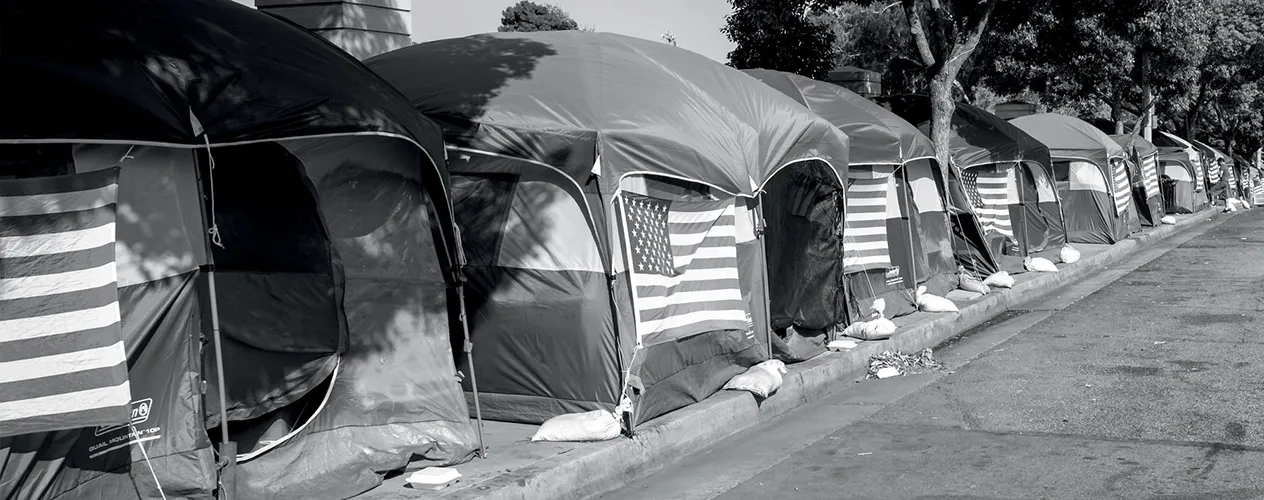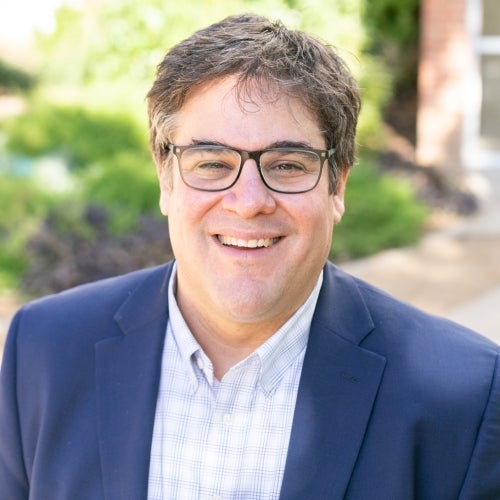No Shelter From The Storm
FSPH’s Dr. Randall Kuhn is part of a research team using a first-of-its-kind platform to learn more about the COVID-19 experience of Los Angeles’ growing homeless population.

HOW HAVE MORE THAN 66,000 HOMELESS people in Los Angeles fared during the SARS-CoV-2 pandemic?
“People are isolated and lonely,” says Dr. Randall Kuhn, associate professor of community health sciences at the UCLA Fielding School of Public Health and a social demographer who studies homelessness. “They’ve experienced a disruption of safety-net services, including the places where they can get even the most basic things. When you close every Starbucks and library, as well as mass transit, it’s going to have a big impact. Those of us who live in houses or apartments hunkered down during the pandemic, but what if you have no place to hunker down?”
While it’s easy to draw certain conclusions, Kuhn notes, specific data on COVID-19 cases, hospitalizations, and deaths is much harder to come by because of the absence of systematic tracking of homeless individuals and their health. In Los Angeles and other cities, fewer COVID-19 deaths have been recorded in the homeless population than expected, but Kuhn and other experts have suggested there may be significant undercounting.
To be sure, living outside provides some measure of protection for homeless individuals from COVID-19, given that the fresh air disperses virus-containing droplets. It’s also easier to remain physically distant, especially since many housed citizens already avoid homeless people. “In one sense, if there were ever an infectious disease not to hit homeless people especially hard, it would be COVID-19,” Kuhn says. “But if we’re calling it a victory for it to be no worse among homeless people than the general population, that’s not much of a victory. All we’re saying is that whereas most infectious diseases are five, 10, or 100 times worse among homeless people than among the general population, this one is no worse.
“But the fact is that it is worse. It’s becoming clearer that once you account for age, homeless people are two to four times more likely than housed people to die of COVID-19. Homeless people are younger on average, but because their bodies have been worn down by their living situation, they don’t do as well with the disease as housed people of the same age."
COVID-19 deaths are just the start. Beginning in March 2020, when the World Health Organization declared the novel coronavirus outbreak a global pandemic, the number of recorded monthly deaths among homeless individuals rose sharply in L.A. County — by about 30% over the same months in prior years. “We know that half of those additional deaths are attributable to drug overdose,” Kuhn says. “We don’t know what the other half are attributable to. But if we can’t say whether this dramatic increase is due to additional deaths of despair, untreated heart conditions, or undiagnosed COVID, we’re in a bad situation.”
The uncertainty is symptomatic of a larger problem that Kuhn and his collaborators are attempting to address. “The homeless population is understudied, and it’s a voiceless population that wants to be heard,” Kuhn says. He explains that there is no shortage of qualitative research giving narrative accounts of the lived experiences of homeless individuals. But public policy is more often made on the basis of quantitative studies, and the vast majority of those use administrative databases that track entries and exits into systems and the use of resources. While this data is useful, questions about health tend to be incidental, and not specific enough to draw policy conclusions.
“There was a series of articles last year about the prevalence of mental illness among homeless people in L.A. — that maybe it’s 15%, maybe it’s 50%,” Kuhn says. “The point is, we’re not using validated measures, and our data are all based on whenever we happen to see the client, but what about the months when they’re not seen? What about the time between when you became homeless and when you were first seen?”
The lack of reliable data on the health of the homeless population makes it hard to obtain support for policies to address it — or, as Kuhn puts it, “No data, no solutions, no justice.”
In collaboration with partners at USC and Akido Labs, Kuhn recently launched the Homeless Research Data Collaborative. At the heart of the effort is a first-of-its-kind platform using mobile phones to build reciprocal relationships with people who experience homelessness and to better understand their lives via monthly online surveys. “Most homeless people in L.A. County have a mobile phone, and for those who do, mobile phones are lifelines in ways that those of us who are housed cannot begin to imagine,” Kuhn explains.
As a proof of concept, Kuhn’s group invited homeless individuals to enroll in the monthly survey, which also includes an interface designed to engage with them and help meet their needs, in partnership with a trusted service provider, the Venice Family Clinic. The survey questions are COVID-19 focused, covering symptoms as well as pandemic-related impacts such as disruptions in medical care, food insecurity, isolation, and depression. Starting in February, the collaborative was in the field with a pilot study surveying homeless individuals about their willingness to get vaccinated for COVID-19. The researchers found that nearly half (46%) of the survey respondents expressed some form of vaccine hesitancy compared with below 30% of the general population, indicating a need for targeted education to overcome both fears and the lack of information for some of L.A. County’s most at-risk residents.
We're never going to stop the inflow of homelessness until we address the housing-supply issue and the issues of poverty and systemic racism.
Separately, Kuhn and his colleagues are in the process of enrolling 800 people for a larger study of homeless individuals as they transition to permanent supportive housing — a strategy that combines affordable housing assistance with support services that address the needs of chronically homeless individuals. The study provides smartphones and financial incentives for remaining in the study, which surveys participants monthly in an effort to better understand the risk of COVID-19 in supportive housing. “A strength of these platforms is their flexibility, which allows us to get new data each month,” Kuhn explains. “We can take the temperature of how a population is doing, especially under threat, and as new needs emerge, we can measure those.” Among the high-priority questions the collaborative hopes to address: What are the health costs of long-duration homelessness, and how can permanent supportive housing be improved to address the approximately 5%-10% who leave and become homeless again each year?
Kuhn believes mobile phones carry great potential for researchers and service providers alike in better reaching and meeting the needs of the homeless population. “Even if you don’t have a phone, you will know someone, or be in an encampment with someone who has one,” he says. Ultimately, he notes, the flow of information can be reversed, so that homeless individuals are providing information, assessments, or updates of their status and needs. “Given the vulnerabilities people have before and while they’re homeless, the only solution is to treat them with humanity and seek to engage and follow them,” Kuhn says. “You can’t have a caseworker assigned to you for life, but potentially you can have an app assigned to you for a very long time so that if you’re losing your hold on what you’ve gained over the last few months or years, there are opportunities to reclaim that."
Homelessness affects wide swaths of the population — including college students. Jessica Richards, a PhD student in FSPH’s Department of Community Health Sciences, is exploring the underlying patterns of housing insecurity and homelessness among UCLA undergraduate and graduate students. Richards conducted interviews with 13 students who have experienced one or more indicators of homelessness, such as sleeping in an unsheltered location. She has found that while students overall are remarkably resilient, housing insecurity negatively affects their physical health, mental health, and academic performance. Importantly, administrative policies can exacerbate student housing insecurity. For example, placing a housing-insecure student in academic distress on academic probation can jeopardize not only their scholarship, but also their education, which is their only source of housing. “I believe that health is a basic human right,” says Richards, who told all interviewees about basic needs services on campus and directed them to the UCLA Basic Needs COVID-19 Resource Guide. “I chose to focus my research on homelessness because housing is health, and the right to health cannot be separated from the right to housing.”
Alex Lawton (MPH ’20) was drawn to FSPH by his interest in serving vulnerable populations. He joined Kuhn’s research team as a student and continues to work with Kuhn as a research associate. “It’s hard to walk anywhere in Los Angeles without seeing people who are experiencing homelessness, and I don’t think most people have a good understanding for how they end up in that position,” Lawton says. “Participating in this research has helped to humanize this population for me — to see the complexities of the situation and how easy it is to end up in that position, especially during a pandemic.”
More than 64,000 homeless people have been housed over the last three years in L.A. County, according to the Los Angeles Homeless Services Authority (LAHSA). But more people become homeless each day than are housed, and as of 2020 there were 66,436 homeless people in the county, according to the Greater Los Angeles Homeless Count — a 13% rise from the previous year’s count. In the short term, Kuhn says, more money, resources, and innovative solutions are needed to increase the stock of housing in the county, which currently is enough to provide shelter for roughly 25% of the homeless population. The pandemic introduced new ideas, including Project Roomkey, a collaborative effort of the state, county, and LAHSA to secure hotel and motel rooms for vulnerable homeless people. Measure H, the quarter-percent increase in sales tax passed by L.A. County voters in 2017, provided an ongoing revenue stream to support strategies to combat homelessness, although significantly more expenditures are needed, Kuhn says.
But short-term solutions aren’t sufficient. “We’re never going to stop the inflow of homelessness until we address the housing-supply issue and the issues of poverty and systemic racism,” Kuhn says. “Without getting to the root causes, these problems will continue.”
